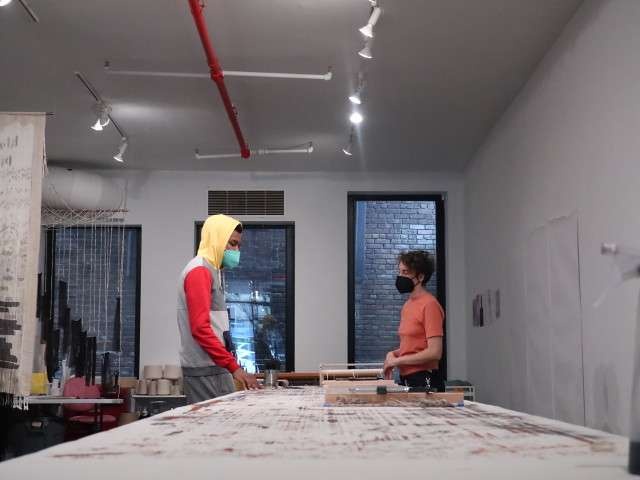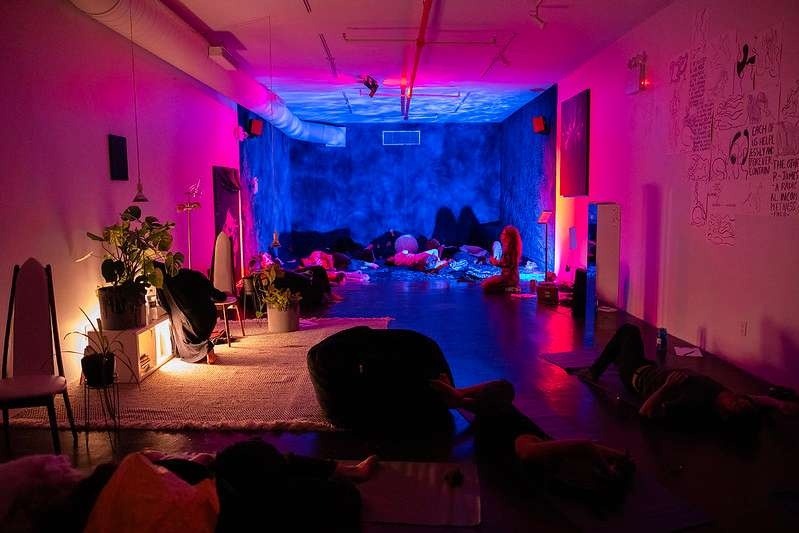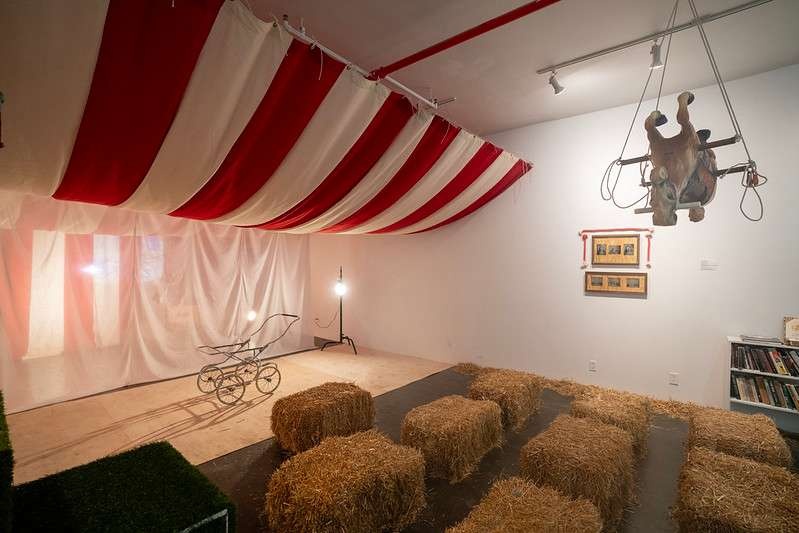I.
I remember the felt gravity of my initial encounter with Rowan Renee’s work as if it were a phantom pressure on my hand. I came across Renee’s installation “No Spirit for Me” (2019) in Marking Time: Art in the Age of Mass Incarceration, an exhibition at MoMA PS1 featuring work by incarcerated, formerly incarcerated, or otherwise systems-impacted artists, curated by Dr. Nicole Fleetwood. Renee procured more than a thousand pages of official documents related to their father’s criminal case—court transcripts, witness statements, police evidence photographs, prison medical records—and then directly translated the papers into lithographs on chiffon, gleaming metalwork, and caliginous weavings. The artist presented an elaborate “evidence room” of these reconstituted state documents delicately suspended within a carceral-bureaucratic architecture of chains and grates. Renee hung the oft-redacted records in cramped rows, within perforated enclosures, or at unreachable heights, evoking the structural obfuscation and barriers to access commonly embedded in the penal system.
Through the time-intensive and undoubtedly emotionally demanding labor of transforming the painful yet banal documents, Renee found that they, too, were transformed; the somatic experience allowed them to find something like closure and a way forward, which the criminal justice system—even in a case declared to be “justice served”—had never provided.
Renee’s Session project at Recess, A Common Thread, grew out of their desire to offer this reparative experience (and the horizons that it opened) to others grappling with trauma, particularly those impacted by the long arm of the carceral state.


Rowan teaching Assembly Fellow Marvens how to work the 25 ft loom
II.
Equal parts creative collaboration, skill share, and healing ritual, A Common Thread invites gallerygoers to participate in a collective weaving, with the artist acting as a facilitator, partner, and guide. Upon entering Recess’s back gallery for a two-hour co-weaving session, I see a lengthy textile-in-progress spilling out from a floor loom onto a 25-foot-long warp-printing table. The thin, taut vertical threads, the warp, are honey-colored and spattered with carmine and black paint; the horizontal threads, the weft, are variegated in hue (forming patches of orange, navy, white, pink, gray) and inconsistent in texture (tufted and wooly, slim and wiry, flat and glossy).
Upon closer inspection, some of the threads aren’t fibers at all: they’re strips of photographs, documents, drawings, and even a bracelet, emotionally freighted materials brought by participants interested in transforming the items’ traumatic content through weaving. As they were interwoven, these sundry materials became abstracted, dissolved, or digested: integrated into the larger fabric as part of a harm response structured on collective processing and co-creation. Renee patiently shows me how to weave with and alongside them, how to pull a wooden shuttle spooled with yarn through the shed—an opening—to guide the weft through the warp, how to backtrack and then move forward when I get stuck.


Detail from an anchor wor in the space. Redacted phrases woven by Rowan Renee.
III.
In the book released alongside the Marking Time exhibition where I first saw Renee’s work, Fleetwood writes about carceral aesthetics, or art made under “conditions of unfreedom” (25). She describes moderating a talk with a formerly incarcerated artist (left unnamed) who “noted that his artwork changed significantly when he went to prison because of the setting, the regulation of time, the constant presence of correction officers, and the limited access to materials,” giving rise to “a more deliberate, repetitive, and sometimes even mechanical process—one that produced labor-intensive, time-laden works that he would not have made outside punitive captivity” (12). Time, which bears a distinct texture and weight in a carceral context, had been meted out as punishment; this artist found a way to make beauty not only in spite of, but also by materially and conceptually engaging, the very things meant to subjugate him. As my fumbling fingers pull the pewter-blue yarn through the weft, again and again and again, I think of him, this artist whose name I don’t know.
IV.
While we weave side by side, enmeshed in the weird alchemy of making, Renee quietly asks me about my relationship with another, related form of transformation: transformative justice. One of the questions inside the question is: do you believe in the ability of people and communities to be transformed? Transformative justice, colloquially known as TJ, is predicated upon such a belief. This abolitionist framework holds that building community accountability practices rather than relying on the penal, carceral, and police state positions survivors of violence to find safety and healing. It strives to create conditions for those who commit harm to take responsibility for their actions and change, and empowers communities—including those marginalized communities disproportionately impacted by punitively oriented state systems—to build infrastructures centered around active, ongoing care for the individuals and relationships that constitute them.
TJ envisions self-determined community mechanisms that end the cycles of violence that state apparatuses perpetuate, while aiding communities in addressing collective trauma inflicted by the state. As time passes, my hands become accustomed to the rhythmic movements that the weft and warp ask of them; my feet become accustomed to the loom’s pedals, which require periodic applications of pressure to lift and lower the frames that form the shed. Before my eyes, so incrementally it is almost imperceptible, the fabric is growing.


Rowan co-weaving with a visitor
V.
A few weeks later, Renee invites me to Stella Adler’s acting studio to observe a group weaving session, which they are facilitating in conjunction with the Reentry Theater of Harlem, a nonprofit that “utilizes art, rituals, and theatrical rites of passage to help individuals address and overcome the shame, stigma, and trauma of incarceration.” The participants already familiarized themselves with weaving basics in a prior session with Renee, and their weavings will eventually be incorporated as props or costumes in a theatrical performance orchestrated by Reentry Theater. As the participants filter in and make their way toward the small cricket looms arranged around a table, the space springs to life with a muddle of weaving, talking, laughing, and crying.
While others in the group weave, a community leader who was formerly incarcerated moves closer to tell me a story. After being repeatedly passed over for promotions, he brought a discrimination suit against the hospital where he worked; in response, the hospital disseminated a vitriolic flier declaring him a threat to security. He explains that several weeks before the Adler workshop he brought a copy of the flier to a Co-Weaving session at Recess, during which he cut the paper into narrow strips and, alongside Renee, methodically wove it into the collective fabric. I realize that I must have seen it: one of the glitchy white rectangles floating in the textile, an afterimage of hurt held tight by saffron-colored threads. “I turned something meant to harm me into something beautiful,” he tells me. “I don’t think even Rowan knew how powerful this was going to be.”
When he returns to me later brandishing an additional, intact copy of the flier, perhaps to incorporate into another weaving, I am reminded that there will always be more fliers; that pain can be soothed and processed and accounted for, but not exorcized; that to be hurt, deeply hurt, is a kind of haunting.


Visitors were invited to touch the final product on unveiling day
VI.
What would a world oriented toward a different vision of justice look like, feel like? There is nothing inevitable about the carceral state and a society that promulgates it; this is true even on the days that it is difficult to believe. At the end of the evening’s session, with the looms stowed away for another day, the artist, docent, videographer, participants, and I all sit in a circle, close our eyes, and focus on our breath.
About the artist
Cassie Packard
Cassie Packard is a Brooklyn-based art writer particularly interested in the intersection of visual culture and queerness / networks / futurity. She has bylines at publications including Architectural Digest, Artforum, BOMB, Bookforum, Financial Times, frieze, Hyperallergic, Los Angeles Review of Books, The Brooklyn Rail, The New Inquiry, and VICE. She has contributed writing, editing, or research to catalogs published by Phaidon, Hauser & Wirth, the RISD Museum, and Ki Smith Gallery. She is currently working on a book, to be released by Frances Lincoln in 2023.
Projects
Explore/Archive
See allDecember 2025
The INSTITUTE FOR TRANSHUMANIST CEPHALOPOD EVOLUTION and Learning from Octopuses
Barbara London
Barbara London reflect's of Miriam SImun's INSTITUTE FOR TRANSHUMANIST CEPHALOPOD EVOLUTION
October 2025
streamlined reflections, courtesy of noise canceling headphones
Gabrielle Rucker
Gabrielle Rucker reflects on the radical intimacy and auditory life at the heart of Deli Radio
July 2025
Tell My Jockey: CUNTRY’s Discourse From the Horse’s Mouth
Ericka Pérez
Assembly fellow Ericka Pérez reflects on clowning, resistance, and CUNTRY’s radical refusal to perform.





